
303-D121 or equivalent

205-153 (T80T-4000-W)

205-142 (T80T-4000-J)

303-409 (T92C-6700CH)

303-1247/1

303-1248
SECTION 303-01A: Engine — 3.5L Ti-VCT
| 2014 Flex Workshop Manual
|
DISASSEMBLY
| Procedure revision date: 05/02/2013
|
 | 3 Jaw Puller
303-D121 or equivalent |
 | Handle
205-153 (T80T-4000-W) |
 | Installer, Differential Bearing Cone
205-142 (T80T-4000-J) |
 | Remover, Oil Seal
303-409 (T92C-6700CH) |
 | Remover, VCT Spark Plug Tube Seal
303-1247/1 |
 | Tool, Camshaft Holding
303-1248 |
| Item | Specification |
|---|---|
| Motorcraft® Metal Surface Prep
ZC-31-A | — |
| Motorcraft® Silicone Gasket Remover
ZC-30 | — |
| Motorcraft® Penetrating and Lock Lubricant (US); Motorcraft® Penetrating Fluid (Canada)
XL-1 (US); CXC-51-A (Canada) | — |
NOTICE: During engine repair procedures, cleanliness is extremely important. Any foreign material, including any material created while cleaning gasket surfaces that enters the oil passages, coolant passages or the oil pan, can cause engine failure.
NOTE: If the cylinder head(s) is replaced, a new secondary timing chain tensioner will need to be installed.
NOTE: For additional information, refer to the exploded view under the Assembly procedure in this section.
All vehicles
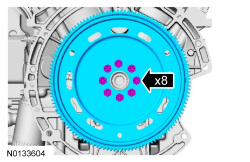
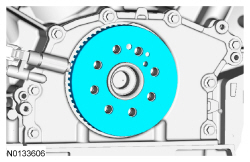
NOTICE: Install the engine stand bolts into the cylinder block only. Do not install the bolts into the oil pan.
Mount the engine on a suitable engine stand.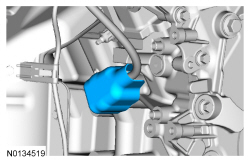
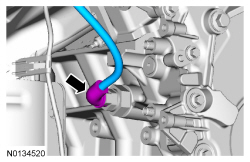
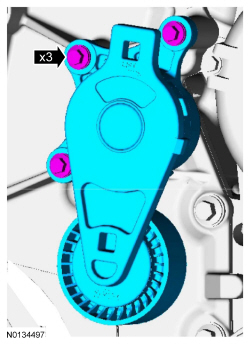
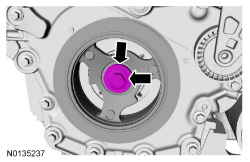
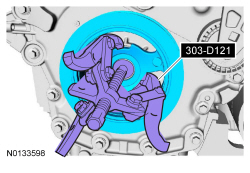
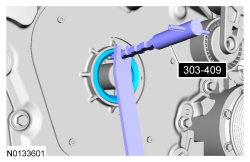
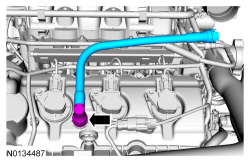
NOTE: When removing the ignition coil-on-plugs, a slight twisting motion will break the seal and ease removal.
Disconnect the 3 LH coil-on-plug electrical connectors and remove the 3 bolts and the 3 LH-coil-on-plugs.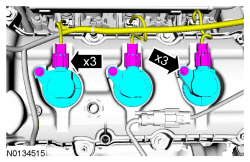
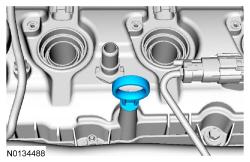
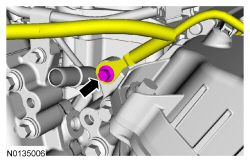
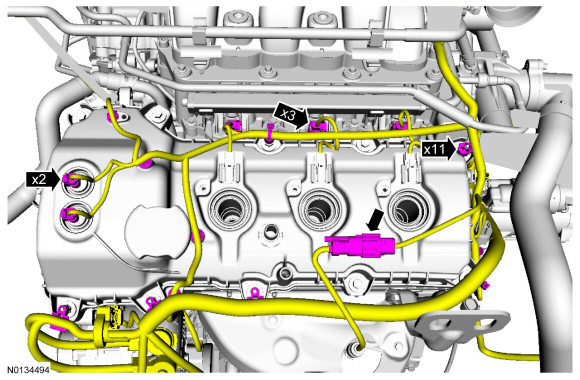
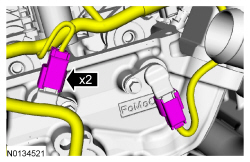
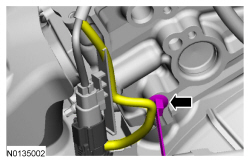
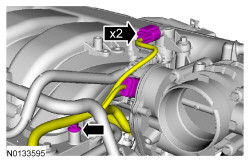
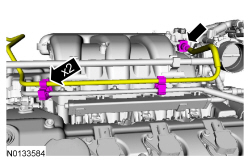
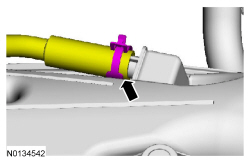
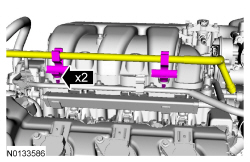
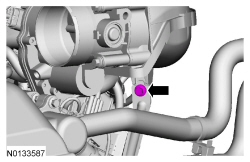
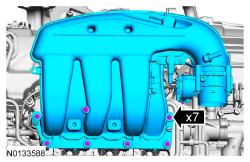
NOTE: When removing the ignition coil-on-plugs, a slight twisting motion will break the seal and ease removal.
Disconnect the 3 RH coil-on-plug electrical connectors and remove the 3 bolts and the 3 RH coil-on-plugs.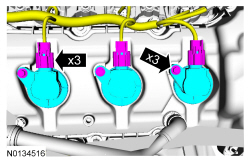
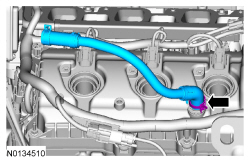
NOTE: On All-Wheel Drive (AWD) vehicles the Catalyst Monitor Sensor (CMS) electrical connector was disconnected during the engine removal procedure.
Remove the engine wiring harness from the RH valve cover.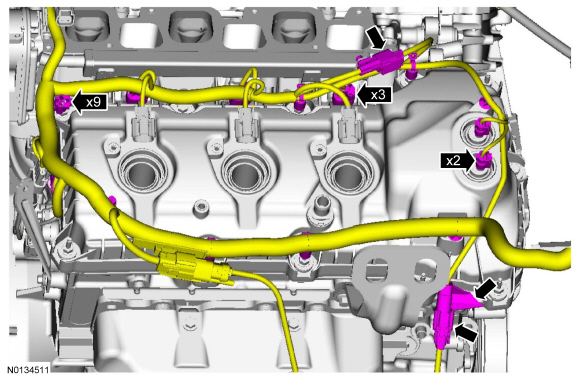
NOTICE: While removing the valve cover do not apply excessive force to the Variable Camshaft Timing (VCT) oil control solenoid or damage may occur.
NOTICE: If the Variable Camshaft Timing (VCT) oil control solenoid sticks to the VCT seal, carefully wiggle the valve cover until the bond breaks free or damage to the VCT seal and VCT oil control solenoid may occur.
Loosen the 4 bolts and 7 stud bolts.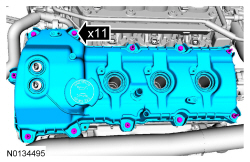
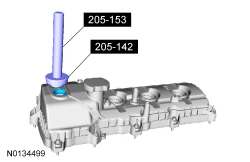
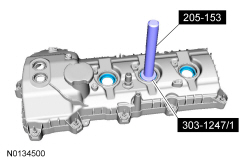
NOTICE: While removing the valve cover do not apply excessive force to the Variable Camshaft Timing (VCT) oil control solenoid or damage may occur.
NOTICE: If the Variable Camshaft Timing (VCT) oil control solenoid sticks to the VCT seal, carefully wiggle the valve cover until the bond breaks free or damage to the VCT seal and VCT oil control solenoid may occur.
Loosen the 3 bolts and 8 stud bolts.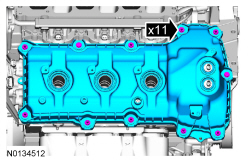
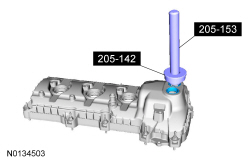
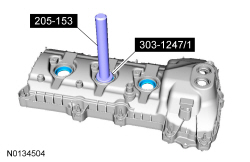
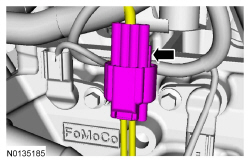
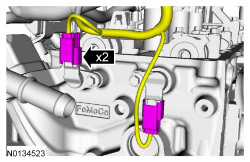
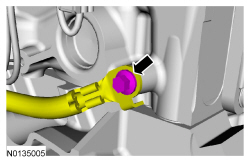
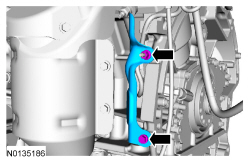
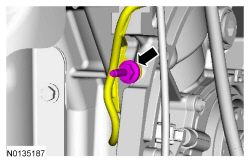
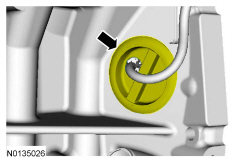
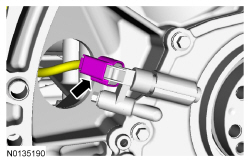
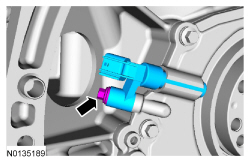
NOTICE: If metal or aluminum material is present in the oil cooler, mechanical concerns exist. Failure to correct these concerns may cause engine failure. To diagnose mechanical concerns, refer to Section 303-00 .
If equipped, remove the 6 bolts and the oil cooler.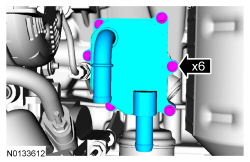
NOTE: Oil filter adapter with oil cooler shown, oil filter adapter without oil cooler similar.
Remove the 3 bolts and the oil filter adapter.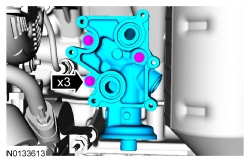
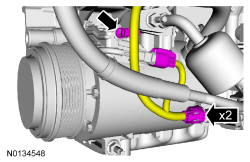
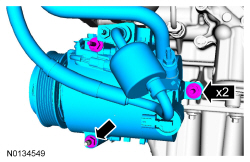
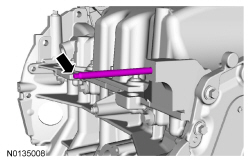
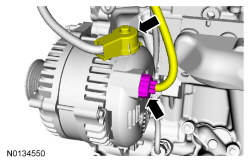
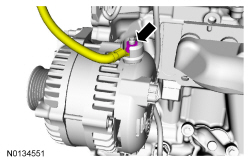
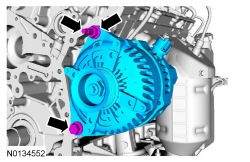
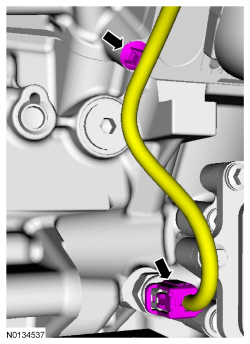
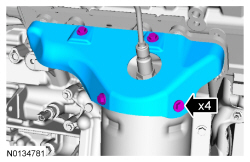
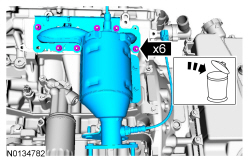
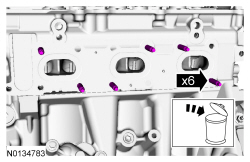
Front Wheel Drive (FWD) vehicles
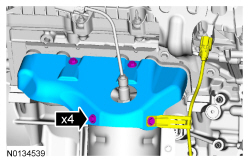
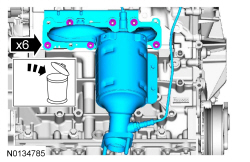
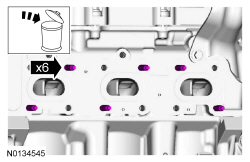
All vehicles

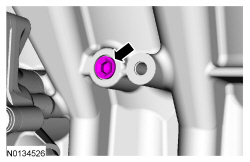

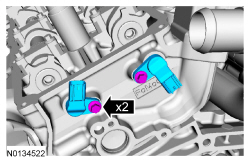
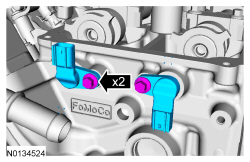
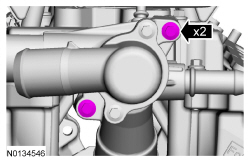
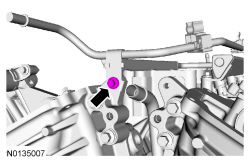
NOTICE: If the engine is repaired or replaced because of upper engine failure, typically including valve or piston damage, check the intake manifold for metal debris. If metal debris is found, install a new intake manifold. Failure to follow these instructions can result in engine damage.
Remove the 10 bolts and the lower intake manifold.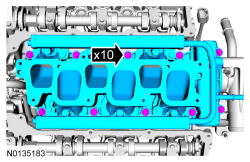
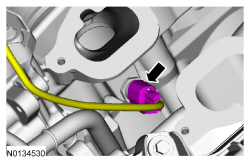
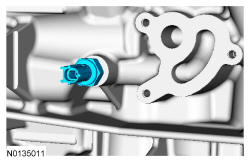
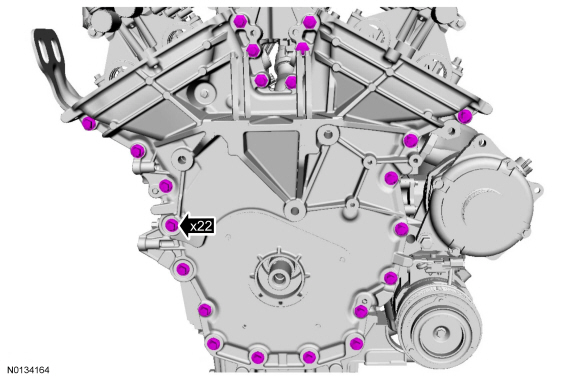
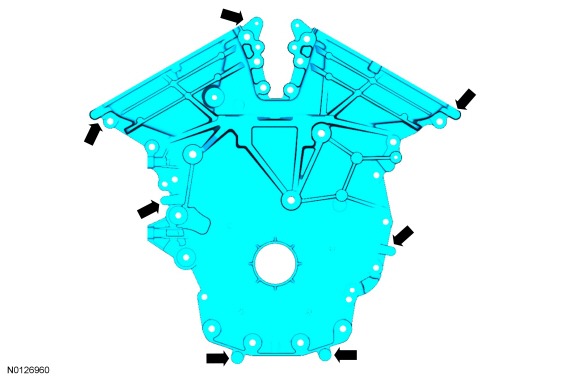
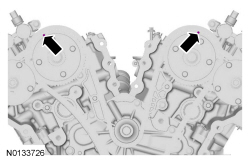
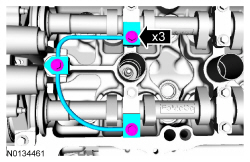
NOTE: The Camshaft Holding Tool will hold the camshafts in the Top Dead Center (TDC) position.
Install the Camshaft Holding Tool onto the flats of the LH camshafts.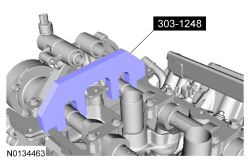
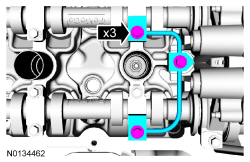
NOTE: The Camshaft Holding Tool will hold the camshafts in the TDC position.
Install the Camshaft Holding Tool onto the flats of the RH camshafts.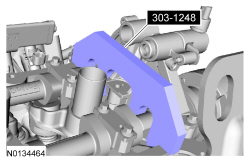
NOTE: The following 3 steps are for primary timing chains that the colored links are not visible.
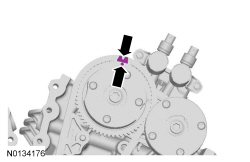
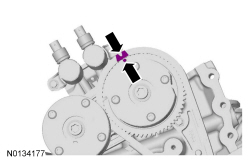
NOTE: The crankshaft sprocket timing mark should be between the 2 colored links.
Mark the 2 timing chain links that align with the timing mark on the crankshaft sprocket as shown.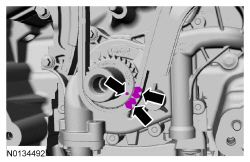
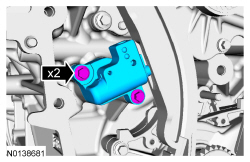
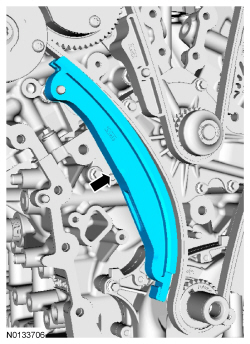
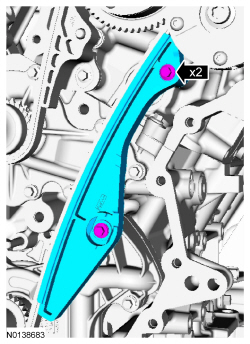
NOTE: Removal of the VCT oil control solenoid will aid in the removal of the primary timing chain.
NOTE: A slight twisting motion will aid in the removal of the VCT oil control solenoid.
NOTE: Keep the VCT oil control solenoid clean of dirt and debris.
Remove the bolt and the LH intake VCT oil control solenoid.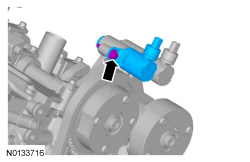
NOTE: Removal of the VCT oil control solenoid will aid in the removal of the primary timing chain.
NOTE: A slight twisting motion will aid in the removal of the VCT oil control solenoid.
NOTE: Keep the VCT oil control solenoid clean of dirt and debris.
Remove the bolt and the RH intake VCT oil control solenoid.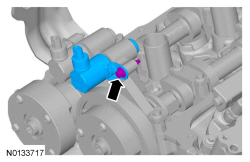
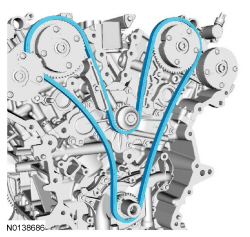
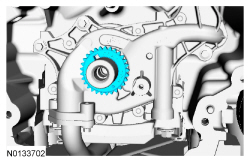
NOTICE: Do not use power tools to remove the bolt or damage to the LH primary timing chain guide may occur.
Remove the bolt and the upper LH primary timing chain guide.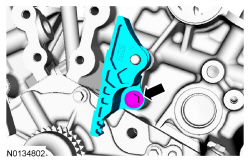
NOTE: The 2 VCT oil control solenoids are removed for clarity.
NOTE: The Secondary Chain Hold Down is inserted through a hole in the top of the mega cap.
Compress the LH secondary timing chain tensioner and install the Secondary Chain Hold Down in the hole on the rear of the secondary timing chain tensioner guide and let it hold against the mega cap to retain the tensioner in the collapsed position.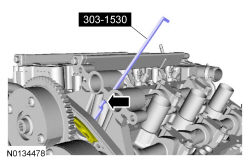
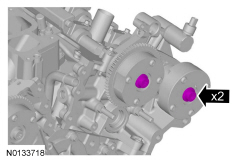
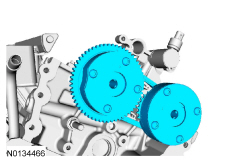
NOTE: When the Camshaft Holding Tool is removed, valve spring pressure may rotate the LH camshafts approximately 3 degrees to a neutral position.
Remove the Camshaft Holding Tool from the LH camshafts.
NOTE: Cylinder head camshaft bearing caps are numbered to verify that they are assembled in their original positions.
NOTE: Mark the exhaust and intake camshafts for installation into their original locations.
Remove the 12 bolts, 6 camshaft caps, mega cap and the LH camshafts.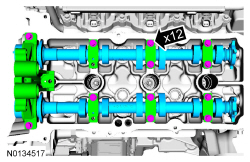
NOTE: The 2 VCT oil control solenoids are removed for clarity.
NOTE: The Secondary Chain Hold Down is inserted through a hole in the top of the mega cap.
Compress the RH secondary timing chain tensioner and install the Secondary Chain Hold Down in the hole on the rear of the secondary timing chain tensioner guide and let it hold against the mega cap to retain the tensioner in the collapsed position.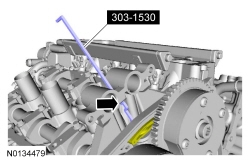
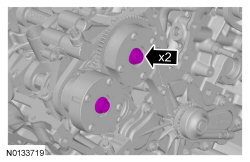
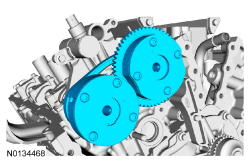
NOTE: When the Camshaft Holding Tool is removed, valve spring pressure may rotate the RH camshafts approximately 3 degrees to a neutral position.
Remove the Camshaft Holding Tool from the RH camshafts.
NOTE: Cylinder head camshaft bearing caps are numbered to verify that they are assembled in their original positions.
NOTE: Mark the exhaust and intake camshafts for installation into their original locations.
Remove the 12 bolts, 6 camshaft caps, mega cap and the RH camshafts.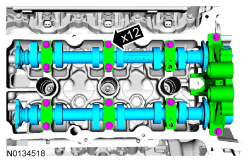
NOTICE: Do not use power tools to remove the bolt or damage to the RH primary timing chain guide may occur.
Remove the bolt and the RH primary timing chain guide.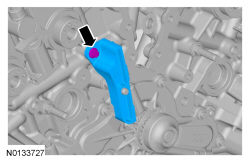
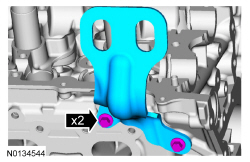
NOTE: Index-mark the location of the bracket on the cylinder head for installation.
Remove the bolt and the upper intake manifold bracket.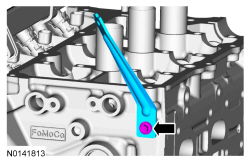
NOTE: If the components are to be reinstalled, they must be installed in the same positions. Mark the components for installation into their original locations.
NOTE: LH shown, RH similar.
Remove the 24 valve tappets from the cylinder heads.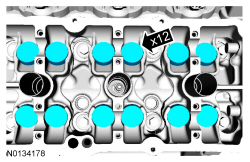
NOTE: LH shown, RH similar.
Remove and discard the M6 bolt.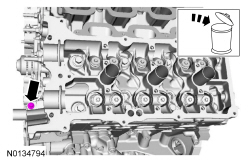
NOTICE: Place clean, lint-free shop towels over exposed engine cavities. Carefully remove the towels so foreign material is not dropped into the engine. Any foreign material (including any material created while cleaning gasket surfaces) that enters the oil passages or the oil pan, may cause engine failure.
NOTICE: Aluminum surfaces are soft and can be scratched easily. Never place the cylinder head gasket surface, unprotected, on a bench surface.
NOTE: The cylinder head bolts must be discarded and new bolts must be installed. They are tighten-to-yield designed and cannot be reused.
NOTE: LH shown, RH similar.
Remove and discard the 8 bolts from the cylinder heads.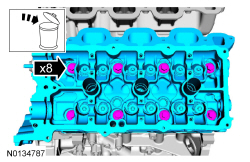
NOTICE: Do not use metal scrapers, wire brushes, power abrasive discs or other abrasive means to clean the sealing surfaces. These tools cause scratches and gouges that make leak paths. Use a plastic scraping tool to remove all traces of the head gasket.
NOTE: Observe all warnings or cautions and follow all application directions contained on the packaging of the silicone gasket remover and the metal surface prep.
NOTE: If there is no residual gasket material present, metal surface prep can be used to clean and prepare the surfaces.
Clean the cylinder head-to-cylinder block mating surfaces of both the cylinder heads and the cylinder block in the following sequence.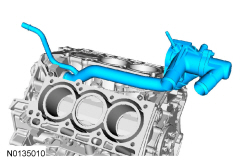
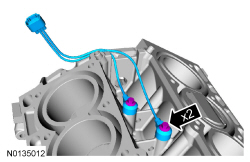
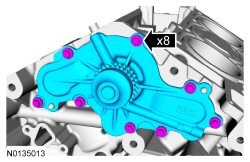
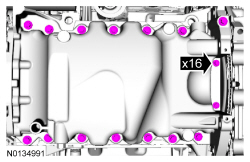
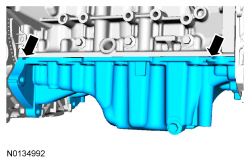
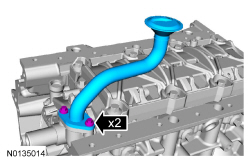
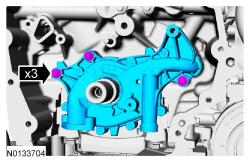
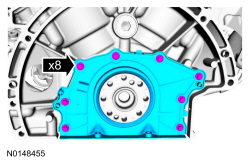
NOTICE: Only use a 3M™ Roloc® Bristle Disk (2-in white, part number 07528) to clean the engine front cover, oil pan and crankshaft rear seal retainer plate. Do not use metal scrapers, wire brushes or any other power abrasive disk to clean the engine front cover and oil pan. These tools cause scratches and gouges that make leak paths.
Clean the engine front cover and oil pan using a 3M™ Roloc® Bristle Disk (2 inch, white, part number 07528) in a suitable tool turning at the recommended speed of 15,000 rpm.NOTE: The main bearing cap support brace bolts must be discarded and new bolts must be installed. They are a tighten-to-yield design and cannot be reused.
Remove the bolts in the sequence shown.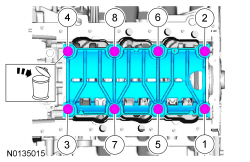
NOTE: The connecting rod cap bolts are a torque-to-yield design. The original connecting rod cap bolts will be used when measuring the connecting rod large end bore during assembly. The connecting rod cap bolts will be discarded after measurement.
NOTE: Clearly mark the position and orientation of the connecting rods, connecting rod caps and connecting rod bearings for reassembly.
Remove the 12 connecting rod cap bolts and 6 cap.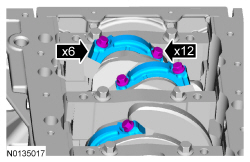
NOTICE: Do not scratch the cylinder walls or crankshaft journals with the connecting rod.
Remove the piston/rod assembly from the engine block.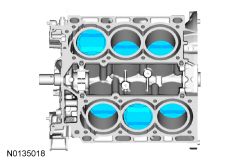
NOTE: The 8 main bearing cap side bolts and the 8 main bearing cap bolts must be discarded and new bolts must be installed. They are a tighten-to-yield design and cannot be reused.
NOTE: Clearly mark the position and orientation of the main bearing caps for reassembly.
Remove the 8 main bearing cap side bolts and the 8 main bearing cap bolts in the sequence shown.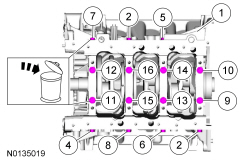
NOTE: If the main bearings are being reused, mark them for correct position and orientation for reassembly.
NOTE: Note the position of the thrust washer on the outside of the No. 4 rear main bearing cap.
Remove the 4 main bearing caps.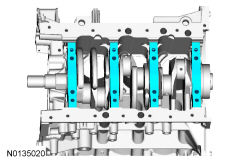
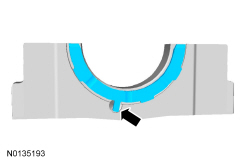
NOTE: If the main bearings are being reused, mark them for correct position and orientation for reassembly.
Remove the 4 crankshaft main bearings from the main bearing caps.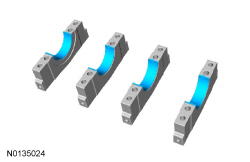
NOTE: Note the position of the 2 thrust washers on the inside and outside of the rear main bearing bulkhead.
Remove the crankshaft.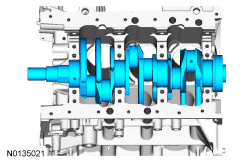
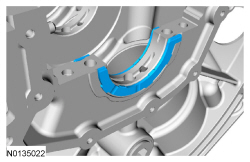
NOTE: If the main bearings are being reused, mark them for correct position and orientation for reassembly.
Remove the 4 crankshaft main bearings from the cylinder block.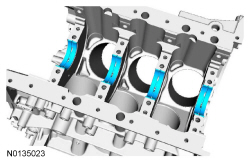
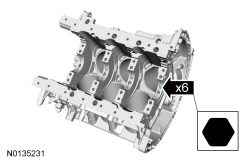
NOTICE: Place clean, lint-free shop towels over exposed engine cavities. Carefully remove the towels so foreign material is not dropped into the engine. Any foreign material (including any material created while cleaning gasket surfaces) that enters the oil passages or the oil pan, may cause engine failure.
NOTICE: Do not use wire brushes, power abrasive discs or 3M™ Roloc® Bristle Disk (2-in white part number 07528) to clean the sealing surfaces. These tools cause scratches and gouges that make leak paths. They also cause contamination that will cause premature engine failure. Remove all traces of the gasket.
Clean the sealing surfaces of the cylinder block in the following sequence.